#osedax worms
Explore tagged Tumblr posts
Text
kind of my biggest dissatisfaction with this human life is that my bones don’t have the necessary amount of lipids to sustain a colony of osedax worms after I die, were I to be buried at sea
3 notes
·
View notes
Text




bitches love my worms
3K notes
·
View notes
Text
Wet Beast Wednesday: bone-eating worm
Happy (almost) Halloween from us at Wet Beast Wednesday. What better to celebrate the spooky holiday than with a spooky animal? These critters are so spooky they even scare skeletons. Sometimes called zombie worms or bone worms, bone-eating worms are scavengers that play an important role in deep seas. Try not to get too scared.
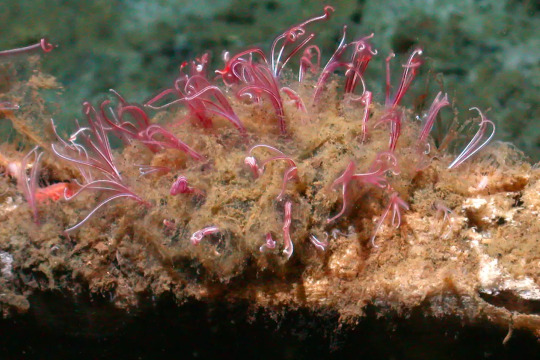
(Image: a cluster of bone-eating worms on a bone. Their plumes are visible, looking like red feathery structures emerging from a clump of brown sludge. End ID)
Bone-eating worms are members of the genus Osedax, with 26 species currently known. My favorite is Osedax mucofloris, which means "bone-eating snot flower". They are small tube worms, reaching between 2.5 and 7 cm (1 to 2.7 in) in length. The body is divided into three segments, the trunk, ovisac, and root. The trunk makes up the majority of the body and it topped by red plumes that act as gills. At the base of the trunk is the ovisac, where eggs are produced. Below that are the roots that bore through the bones the worms live on. This is done by secreting carbonic acid that is produced through anaerobic respiration. The roots also produce a mucus sheath whose purpose is not fully known. It may protect the body from the acid or may prevent the acid from dissolving the hole the worm lives in. As with other tubeworms, the worm generated a protective sheathe to live in. Normally, the plumes extend out of the sheathe to respirate, but when threatened, they will withdraw into the tube.
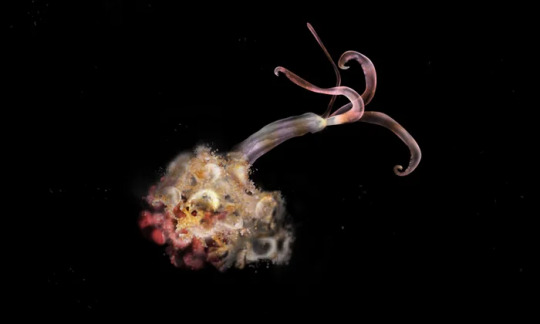
(Image: a bone worm removed from the bone. It is a long, translucent tube with reddish plumes on one and a lump of wavy roots on the other. End ID)
Bone-eating worms lack a mouth, anus, and digestive system. To obtain nutrients, they exist in a symbiotic relationship with bacteria. As the worms break down the bone, they release lipids and proteins that the bacteria consume to produce energy in the form of glycogen, which is transferred to the worm. The worm then uses the glycogen to power itself and feeds it to the bacteria to keep them alive. The worms also use collagen, which is the primary component of bone. Many of the symbiotic bacteria species need the collagen, which the worm provides by breaking down the bone. Curiously, many of the symbionts produce toxins that disrupt the membranes at the roots, leading to infection. The bacteria are also found surviving outside of symbiosis with the worms Because of this, it is debatable whether the relationship between the worm and its bacteria is mutualistic (both parties benefit) or commensal (one party benefits, the other neither benefits nor suffers).
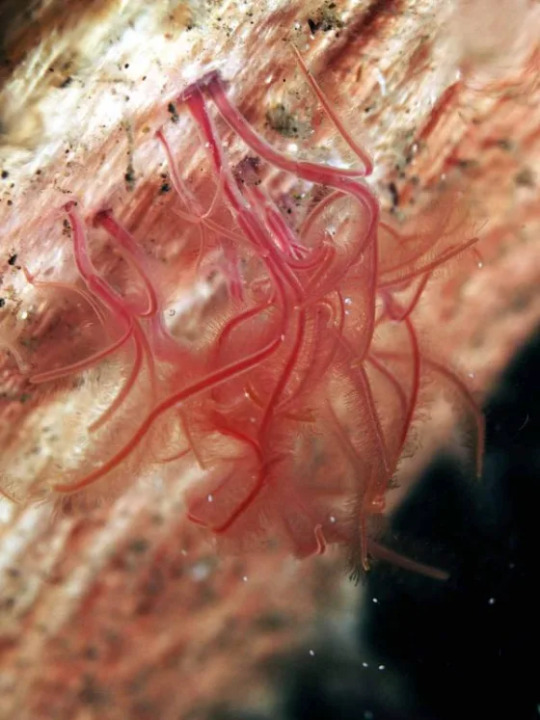
(Image: a cleared view of bone worm plumes emerging from a bone. End ID)
Bone-eating worms are found worldwide in oceanic depths ranging from 10 to 4,200 meters (30 to 14,000 ft). They are most commonly found on the skeletons of whales, but will also colonize fish bones and even, in one experiment, cow bones. Whale bones seem to be preferred both because of their large size and the large quantity of lipids found within. Whale skeletons can often be seen covered with bone worms, giving them the appearance of red shag carpeting. As the worms break down bones, other animals can take better advantage of the nutrients within. The presence of bone worms at a whale fall has been shown to increase the biodiversity of the site. Bone-eating worms are ecosystem engineers, organisms that significantly alter their habitat. They have been doing this since before whales existed. Fossil sea turtle and plesiosaur bones have been found with signs of bone worm colonization.

(Image: a lone bone worm with its tube visible. Its plumes are whitish. End ID)
The bone-eating worms have one of the most dramatic cases of sexual dimorphism in the animal kingdom. All the worms you see when you look at a whale skeleton are females. The males are 20,000 times smaller and fully microscopic. They still resemble larvae, making them a case of neoteny, an adaptation where juvenile characteristics are retained into adulthood. Harems of males live inside the females' tubes and feed on the nutrients released by the bacteria. As the female generates eggs, the males fertilize them. The eggs hatch inside the female's tube and stay for a while to mature before being released into the water. The fact that the worms are so widely distributed indicated that the larvae can travel vast distances to find a new set of bones, but the means they use to do so is unclear. The extreme sexual dimorphism reduces competition between males and females and ensures the males will always have an available mate to pass on their genes. The species Osedax pirapus do not follow this form of dimorphism. Males are still smaller than females, but they actually look like worms and share the same lifestyle. This increases competition between males and females, but ensures that males can make far more sperm due to their greater size.
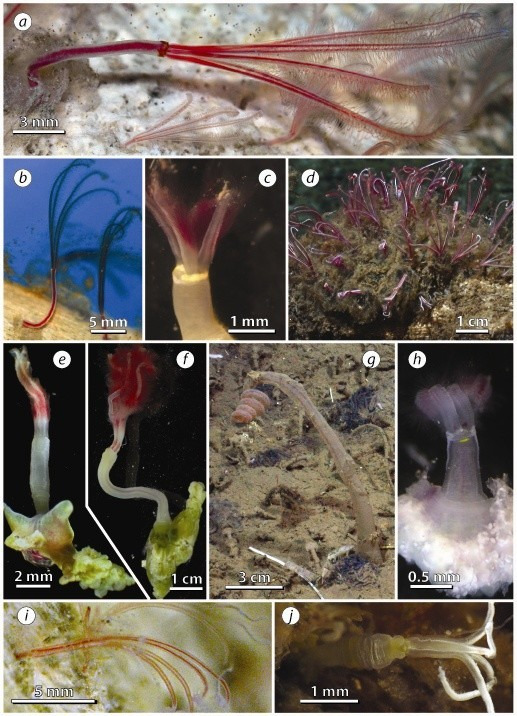
(Image: a collection of images of multiple species of bone-eating worms. Source. End ID)
#BONES FOR THE BONE WORM#wet beast wednesday#bone eating worm#bone worm#zombie worm#osedax#worm#tube worm#polychaete#wormblr#halloween#whale fall#invertebrates#invertiblr#marine biology#marine life#biology#ecology#zoology#animal facts#informative#educational#image described
219 notes
·
View notes
Text
BONE WORMS! 🦴🪱
Sorry for not posting in a while, things have been busy so I offer this post as atonement. Today I share with you a genus of polychaetes that I think is neat, the humble Osedax, AKA bone worms
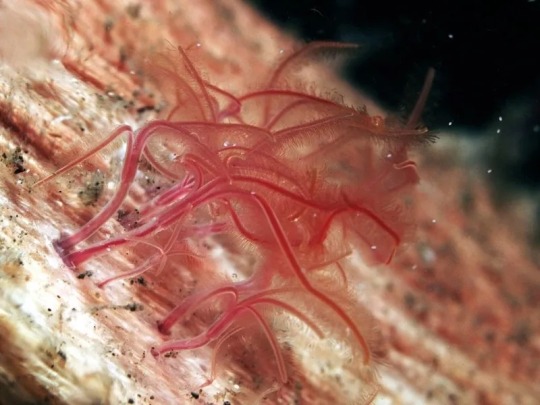
If you like whalefalls then you’ve probably heard of these little freaks. These worms have adapted to the unique lifestyle of feeding on sunken vertebrate bones and absolutely thrive at whalefalls. Though most associated with whales, they are not picky and will feed on any type of bone. Amazingly, fossil evidence of their activity has been found from the Cretaceous on the bones of marine reptiles like mosasaurs, millions of years before whales even evolved!
You might think they’re feeding on the marrow or fats within the bone, but they actually feed on the collagen. To understand how they do this, we’ll need to pull one out of the bone and see what lies beneath…

what the hell is that?? This is the worm’s ‘root’, a unique structure that bores into the bone by secreting enzymes and acid that break down the bone’s matrix. The root is also home to endosymbiosic chemoorganotrophic bacteria. This is just a fancy way of saying symbiotic bacteria living in their tissue that feed on organic compounds. These bacteria metabolise the collagen into useful compounds for their worm host.
What’s even weirder is that only the female worms look like this. The males are microscopic and live within the female’s trunk. Over time, a female can amass a harem of multiple malewives. This dimorphism likely evolved due to it being rather difficult to find a mate on the ocean floor when you’re a sessile worm stuck to a bone. With a constant supply of sperm, the female can release hundreds of eggs into the water that hatch into free-swimming larvae which spread out and find new bones to colonise.
I’ll stop rambling there but I hope you guys find these things as interesting as I do :) I had to write a 2k essay on these things so if anyone has any questions about them feel free to ask 🪱🦴
#biology#marine biology#stemblr#stem academia#science#worms#ocean life#sea critters#sea creatures#whalefall#whale fall#bone worm#osedax#zoology
43 notes
·
View notes
Text

A portrait of an Osedax--a little marine worm that digests whale skeletons. I picked rubiplumus 'cause she's pretty and pink.
24 notes
·
View notes
Text
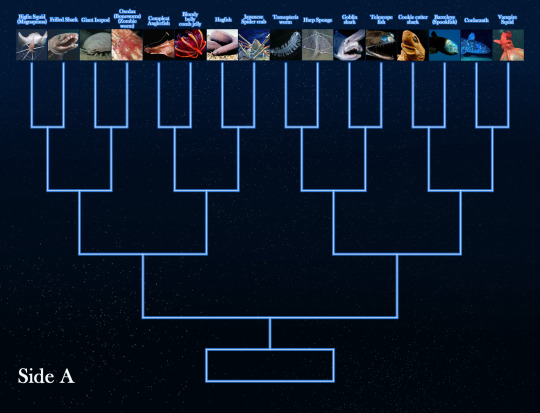
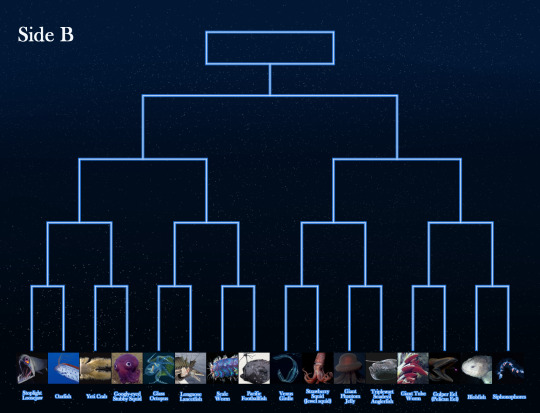
Deep Sea Fish Tourney Round 1 Brackets!
THE GIRLS ARE FIGHTING!!!!!! Side A's polls have concluded, and side B polls are now up!
Both sides have concluded!
Masterlist under the cut
Side A (concluded):
Bigfin Squid (Magnapinna) vs Frilled Shark
Giant Isopod vs Osedax (Boneworm/Zombieworm)
Compleat Anglerfish vs Bloody Belly Comb Jelly
Hagfish vs Japanese Spider Crab
Tomopteris Worm vs Harp Sponge
Goblin Shark vs Telescope Fish
Cookie Cutter Shark vs Barreleye (Spookfish)
Coelacanth vs Vampire Squid
Side B:
Stoplight Loosejaw vs Oarfish
Yeti Crab vs Googly-Eyed Stubby Squid
Glass Octopus vs Longnose Lancetfish
Scale Worm vs Pacific Footballfish
Venus Girdle vs Strawberry Squid (Jewel Squid)
Giant Phantom Jelly vs Triplewart Seadevil Anglerfish
Giant Tube Worm vs Gulper Eel (Pelican Eel)
Blobfish vs Siphonophore
#tumblr competition#tumblr showdown#fish pictures#deep sea fish tourney#deep sea fish#brackets#bigfin squid#magnapinna#frilled shark#giant isopod#osedax worm#osedax#compleat anglerfish#bloody belly comb jelly#hagfish#japanese spider crab#tomopteris worm#harp sponge#goblin shark#telescope fish#cookie cutter shark#barreleye#spookfish#coelacanth#vampire squid#stoplight loosejaw#oarfish#yeti crab#tumblr. does not let me tag all of them. fair#round 1
97 notes
·
View notes
Text
Zombie Worms



Name: Zombie Worm
Scientific Name: Osedax Roses
Family Name: Siboglinidae
Location: They are found worldwide.
Status: Least Concern
Fun Facts:
• Zombie worms eat bones! they are most commonly found in whale carcasses.
• They have no mouth or stomach, so they consume their food by secreting acrid. This dissolves the bone and allows them to access the nutrients inside. We still don't know exactly how they get the nutrients from there.
• Female zombie worms usually have 50-100 tiny males living inside of them. The females continually find new males to reside in them.

Sources: 🌊 / 🌊 / 🌊
#sea creature of the week#marine life#sea creatures#info blog#marine biology#ocean#ocean creatures#ocean life#sea critters#sea life#zombie worm#osedax
2 notes
·
View notes
Text


please help me achieve my dreams
#I watch a lot of deep sea docs to fall asleep#hell yeah osedax worms#down there living their best life#this was from last December I was going through it also#unrelated.#.doc#doodles
26 notes
·
View notes
Text
knowing that i initially started this blog with the intention to only run it for maybe a week, this is an absolutely insane development.
thank you so much everyone. may we all enjoy many more creatures!
String identified: taccttttctttttgtcAataagactatttgtcttttattggtagtcaataAtgattattcggtatagaatactcttatcctaataaactcattagttcatataatcataagcctaattttatttgattcatcttctttCatatcatttttatAgacctgatattgtcttttgactatttgacTagattagggttcatctttagattagcattatttatgccgactagctatgttaagaacttgtcATTaagtaaaaGaaattttgtatTaaattTtgaagtctgcgaaTAgtattattgtatttggttatagcaaattattgttataTgcgataccctaatactttttttttgataaaAagttgtgtctactatattatcattatataggcgtatgtacacgaagactataactacgttctagattagatTaatatcaataatataTagaaagactgaCaccaaatatttaccatctaattgttattatctcggactatattcActaactttataacatcgtccgtgacgaagactataccaagattaaatgatacctagcgtgttattgatttactaTtctaaTtatattaattacAgattatattaactgattgaatgtgatataattctatgatgaacttgaatcgttgtagataacaatgttgtttatgcattttccatagactatatgcagtgacaattattatacattagactgacacaaatgatttctatagatagactgatacatatgagtattGatctTtacatcataatgacataactttttgcgtacttactatattacctttattacattgattGATAGACTTattataAtaattatttttattgattattatgtttgatagacttgattttaccatataaattgacttgatagttcaaagtgtaagcgtactttagagtattatattgttttttaataatattacaaacat
Closest match: Osedax frankpressi genome assembly, chromosome: 6 Common name: Bone Eating Worms

(image source)
Now for the final round!
@hellsitegenetics
I love them
I didn't know I needed to know that the weed-smoking girlfriends post was genetically a wolf, but I did, and I do. Also puts great stuff on my dash.
it’s so fun to be scrolling unhinged posts and then boom. an organism!
so many moths‼ also, unexpected comedy with some of the matches
perfect blend of silly and informative, and makes for an excellent punchline at the end of a long post. puts creatures on my dash. literally what more could you ask for
It's a really unique blog concept and a lot of times the results are pretty funny. It's great when the sequence matches the post content too!
Creatures 👍
Finds beautiful creatures out of the mess of the hellsite
Offers finality AND gives us a creechur.
I love them. English speakers talk like moths
If this blog wins, they could run the text of the winning announcement, and determine the post's genus and species!
They're also very good about tagging the type of creature depicted in the results, so as long as you mute tags of creatures you don't want to see, it's a very fun time seeing iconic legacy posts (and new submissions) being reduced down to a string of letters and assigned a random species of fish or moth or something!
uhh it’s cool
BLAST
There are so many weird bugs in the world
Yippee!!
If, as Haldane said, God has an inordinate fondness for beetles, then surely this blog proves that Tumblr has an inordinate fondness for moths.
Top tier blog as a geneticist, I love seeing obscure organisms and MOTH
Admin got rate limited after trying to blast the bee movie
the knowledge of biology to pull this off (i have taken one biology class in my life) and also the work to find all the strings honestly deserves quite a bit of praise
This gimmick blog has it all: science, pictures of animals, interaction with the text of other peoples' posts, interesting information, and a unique and fun premise. As a biologist, I'm rooting for hellsitegenetics to reach the end and take the tournament, because it is truly a standout among gimmick blogs.
If they win, perhaps this blog too shall become a cool organism :3
@hasgavlebockenburneddownyet
What's more happy holiday cheer than cheering on the destruction of a giant straw goat?
The birds may have won 2023, but I believe in humanity's capability for arson for 2024 <3
a vote for me is a vote for arson! This message was approved by hasgavlebockenburneddownyet
gavle is SUCH a public service and holiday feature
what's more tumblr than comical destruction and holidays?
sometimes you just gotta vote with your matchsticks
Bringing a cultural staple to tumblr since 2021
Arson is so much more fun
It would be really funny and ironic if it survives the tournament
you have no idea how much joy watching the chronicling of the gavlebocken brings me every year
hasgavlebockenburneddownyet provides an essential public service
always love seeing a bit of Swedish history on my dash 'Swedish bamboo season'
the goat account is peak gimmick blog
If I don't get to beat the goat then nobody does. -pointless-achievements
Never ask Tumblr to choose between lies and arson! The winner threatens by nature to rip apart the very fabric of our DNA!
goat statues made out of straw are exciting and interesting
I wanna see things burn
the goat is an essential part of tumblr culture and the goat blog is a sacred keeper of the tumblr high holidays
watching to see if the big straw goat has burned down each year is a true delight, something I never knew existed until tumblr and the blog dedicated to it
the incredibly focused nature of @/hasgavlebockenburneddownyet is what makes their gimmick superior.
Please guys bite gavlebocken
Look, I'm Danish. I was put on this earth to annoy the Swedes and vice versa, but even I voted for @/hasgavlebockenburneddownyet
gavlebocken is also such a fun name and this blog informed be about its existence, so for that I am grateful
hasgavlebockenburneddownyet is providing a vital service! Every year, people rely on their updates regarding the fate of our most beloved Yule Goat! How could they NOT deserve the win!?
sacred anti-corporate arson
a vote for gävlebocken is a vote for anarchy!
pls vote for them they're the funniest gimmick keeping track on the funniest phenomena in recent human history, like when i look at their acc i think to myself this is what tumblr was created for
the goat is the GOAT
HASGAVLEBOCKENBURNEDDOWNYET DESERVES TO WIN, I have them on post alert for a REASON
the holiday season wouldn't be the same without them
they do important reporting. Do you look at the news and be like 'the reporters aren't doing work they're just telling you whats happening.' Have some respect for the goat news
let the weird burnt sacrificial ritual of it all appeal to you
nothing makes my December more interesting, arson should win
doesn't barge in on other peoples posts which is always a good thing in my books. not a fan when obnoxious gimmick blogs turn a decent post into a garbled mess
#gimmick-blog-bracket#hellsitegenetics#tumblr genetics#genetics#biology#ocean#worms#marine worms#osedax#bone eating worms#<- no way we also got my favorite marine worms for this too. i love osedax#im totally speechless i just want to jump around and go YIPPIE!!! yknow?#thank you again everyone. it's been awesome
9K notes
·
View notes
Text

poem in text form under the cut
Osedax
Waltmarie poem
Sinking, falling ever deeper into the abyssopelagic- It’s time To let past thoughts fade away with the light To let Myself settle into the soft mud of the abyssal plain. Bone worms Sway in the frigid water, burrowing roots into me; a polychaete Carpet That wastes nothing, extracting the lipids from My corpse.
Now go back and read only the short lines.
#writing#creative writing#poetry#poem#original poem#poems on tumblr#words words words#writblr#osedax worm#boneworms
1 note
·
View note
Note
would you perhaps do the Danny Phantom opening theme?
https://dannyphantom.fandom.com/wiki/Danny_Phantom_Opening
String identified: ' a at a at, a at, a at g a t, a t at t a tag ac t a g t a (' ga catc ' a 'ca ' a at) t 't t , , t t t t t a t a t T a a gat g a, tg t cag c gt a aag (at, at) t , a a -t a A gg g c a tg a, aa, a a c ta t t g t a t tat at a t a t t a t gt cg tg ' t gt a ' ga catc ' a 'ca ' a at Ga catc ' a 'ca ' a at Ga catc ' a 'ca ' a at
Closest match: Osedax frankpressi genome assembly, chromosome: 6 Common name: Bone-eating Worms

(image source)
#tumblr genetics#genetics#asks#requests#sent to me#danny phantom#ocean#worms#bone-eating worms#this is one of the coolest things to show up on the blog so far holy shit#these worms eat whale carcasses#the genus name osedax literally means bone eating#they're also known as boneworms or zombie worms#fucking badass all around. absolute perfection#thank you danny fenton
2K notes
·
View notes
Text
Uncharismatic Fact of the Day
Members of the genus osedax don't want any candy for halloween this year-- just bones! More commonly known as bone-eating worms or zombie worms, these species are most commonly found on whale falls, where they burrow deep inside the carcass' bones to reach the nutrient-rich fats.

(Image: A colony of bone-eating worms by Yoshihiro Fujiwara)
#zombie worms#bone-eating worms#Sabellida#Siboglinidae#annelid worms#segmented worms#worms#invertebrates#uncharismatic facts
153 notes
·
View notes
Text
Collecting a whale vertebra to show folks is soooo last Tuesday. Now, a real educational institution will drop the whale bone into the ocean so it can get good & haunted, so they can show you the special whale bone ghosts.
Whale, whale, whale, look what the ROV dragged in… 🐋🦴🤔
⚠️TW: graphic image of dead whale⚠️
In 2021, a dead fin whale washed up on a beach in Monterey Bay, giving us the unique opportunity to collect one of its back bones for display in the Into the Deep/En lo Profundo exhibit at the Aquarium.
Before its debut, MBARI helped us sink it in the deep sea to “marinate”. Three years later, we returned to retrieve the whale bone, freshly colonized in Osedax bone-eating worms!
Check out this collaborative process with @mbari-blog to bring the deep sea closer to you!
1K notes
·
View notes
Text
Midweek moment of zen brought to you by bone-eating worms 🦴
Lacking mouths and guts, Osedax worms survive by producing a “root system” that digests the surrounding bone and releases collagen and lipids that the worm then consumes. The roots produced by these unique worms also house symbiotic bacteria that appear to play a crucial role in nutrition. Since 2004, scientists worldwide have discovered over 30 species of Osedax occurring at depths from 10 to 4,000 meters (32 to 13,123 feet). Various species can colonize a broad array of bones from fish, marine mammals, birds, turtles, and terrestrial mammals. These worms can quickly consume bones, removing visual evidence of a sunken whale skeleton in as little as a decade.
125 notes
·
View notes
Text
Writing Notes: Whale Fall

Whale Fall - the carcass of a whale that sinks to the seafloor when it dies. It provides a sudden, concentrated food source and a bonanza for organisms in the deep sea for years to come.

Common Organisms Found on a Whale Fall: 1 = Hagfish; 2 = Sixgill Shark; 8 = Giant Isopod

3 = Rattail Fish; 4 = Eelpout Fish; 5 = Sea Pig; 6 = Pom-Pom Anemone; 7 = Muusoctopus; 9 = Amphipods; 10 = Grooved Tanner Crab; 11 = Hesionid Worms; 12 = Ampharetid Worms; 13 = Osedax Worms; 14 = Brittle Star; 17 = Hooded Shrimp; 18 = Squat Lobster

15 = Rubyspira Snails; 16 = Mussels
Whale Fall in Monterey Bay National Marine Sanctuary

When a whale dies, the story has just begun. The massive carcass sinks to the seafloor, where it provides food for a deep sea ecosystem on the otherwise mostly barren seafloor. There are several stages to the whale fall ecosystem as different parts of the whale are used up.
Timeline of a Whale Fall

Stages of a Whale Fall
Scientists have identified 4 stages of a whale fall. The stages – which often overlap or blend together – start with the head (Stage 1) and end at the tail (Stage 4). The duration of these stages is estimated, and varies depending on the size and species of the whale.

In the 1st phase, mobile scavengers such as ratfish, hagfish and sharks smell whale on the water and swim from afar, feeding for up to 2 years on the dead whale's soft flesh.

In the 2nd phase (the enrichment-opportunist stage), worms, crustaceans and mollusks feed on leftover blubber, often burrowing into the nutrient-enriched sediment beneath the whale for around two years.

The 3rd stage (sulfophilic stage) can last decades. With only the skeleton remaining, bacteria begin breaking down lipids trapped inside the bones, generating sulfur, which attracts more bacteria and a larger community of diverse and rare species including mussels, worms, snails, and others. This diversity of species found in this last stage is larger than any known community on the deep seafloor.

In the 4th stage, the mineral remains of the skeleton are colonized primarily by suspension feeders exploiting flow enhancement and hard substrates after the depletion of organic material.
Creatures of a Whale Fall





Sources: 1 2 3 4 5 6 ⚜ More: Writing Notes & References
#requested#whale fall#writeblr#dark academia#writing reference#spilled ink#literature#writers on tumblr#writing prompt#creative writing#light academia#lit#writing ideas#writing inspiration#nature#animals#writing resources
70 notes
·
View notes
Text
W h a l e f a l l
C.W: Whale corpses

When a whale carcass floats down to the ocean floor in the abyssal zone, it creates an ecosystem called a 'whalefall', where a variety of deep marine life can live and be sustained for over 50 years.
This ecosystem has 4 stages:
Mobile Scavengers Stage

The first stage is when scavengers from around the plain gather to feast on the whales flesh - Typically by hagfish and sleeper sharks - until there is just bone.
This stage can last for months or up to 1.5 years.
Enrichment Opportunists Stage

This stage is when smaller scavengers - such as octopuses, crustaceans and molluscs - gather around the whale looking for tissue and bits of carcass left over from the first stage. This is also when osedax (boneworms) arrive and comsume the community of bacteria that eat the bone lipids.
This stage can last months or up to 5 years.
Sulfophilic Stage

In this stage the majority of scavengers have left and in its place are the boneworms and the community of chemosynthetic bacteria that break down the lipids in the bones and produces sulphide that can be consumed by other organisms like worms or shrimp.
This stage can last over 50 years.
Reef Stage

The final stage is when all the consumable material have been exhausted and the leftover bone creates a hard surface for abyssal filter feeders to latch onto. A 'reef' of sorts.
Whalefalls are one of many essential food-falls that sustain life at the bottom of the ocean, and are p cool i think anyway im done w my autism rant goodbye
#sorry i wasnt sure how to end it#marine#marine biology#marine life#oceancore#oceanology#oceanography#whales#whalefall#marine ecosystem#marine ecology#ecology#ecosystem#the abyssal#deep ocean#deep sea#science#science facts#fish#ocean floor#ocean#Sea floor#marine animals#seacore#pacific ocean#sailorcore#nautical#tw decay#tw corpse#ocean aesthetic
1K notes
·
View notes